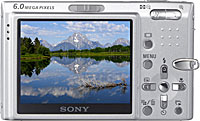 Sony continues to build on the success of its ultra-slim DSC-T digital still camera range with the release of the six megapixel Cyber-shot DSC-T9 model.
Sony continues to build on the success of its ultra-slim DSC-T digital still camera range with the release of the six megapixel Cyber-shot DSC-T9 model.
Following in the footsteps of the T3, T5 and T7 models, Sony’s new mini-snapper manages to add optical image stabilisation and high light sensitivity, with the company claiming pictures with “significantly less blur and graininess than typical point-and-shoot cameras.”
The camera shoehorns a smarty-pants lens-shift optical image stabiliser that does it stuff courtesy of two gyro-sensors which detect hand movement and automatically calculate the necessary compensation for a crisp image.
The increased high light sensitivity (64 up to IS0 640) allows punters to grab flash-free, atmospheric shots in low light, although we’ve yet to see how effective Sony have been in keeping the inevitable noise down at high ISO ratings.
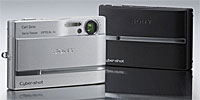 “Our T Series set the standard for slim, stylish, point-and-shoot cameras with fine image quality,” said James Neal, director of digital imaging products at Sony Electronics.
“Our T Series set the standard for slim, stylish, point-and-shoot cameras with fine image quality,” said James Neal, director of digital imaging products at Sony Electronics.
“Now the use of this category of cameras is pervasive. With the DSC-T9, we are taking this category a step further by incorporating advanced imaging technologies that ensure that you get the shot, even in unfavourable light conditions, like nightclubs and restaurants,” he added.
As with previous DSC-T models, there’s a whopping great 2.5-inch 230k LCD dominating the rear of the camera, with four playback ‘themes’ letting users display their photos with dynamic transitions shuffling along to user-selected music clips.
The Lilliputian shooter comes with a 3x (38-114mm ) Carl Zeiss Vario-Tessar folded-path optical zoom so there’s no whirring lens thrusting out of the camera on start up.
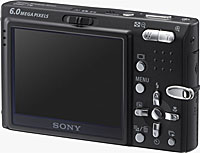 The DSC-T9 offers shutter speeds from 30 to 1/1000 second, Multi-pattern, Centre-weighted, or Spot metering, five white balance presets and 10 scene modes.
The DSC-T9 offers shutter speeds from 30 to 1/1000 second, Multi-pattern, Centre-weighted, or Spot metering, five white balance presets and 10 scene modes.
There’s also VGA (30 fps) MPEG movie recording onboard, with 58 MB of internal memory and a slot for an optional Memory Stick Duo or Memory Stick PRO Duo media card.
Turning the camera on and off is a matter of sliding the camera lens cover, with Sony claiming a battery life of up to 240 shots per charge – an improvement on the fairly dire performance of its predecessor.
The Cyber-shot DSC-T9 camera will be available in January for about $450 (~£254~€374) online at SonyStyle.com
 Travelling photographers and road warriors should love the new credit-card sized USB key from LaCie, offering a massive storage capacity of either 4Gb (4,000Mb) or 8Gb (8,000Mb).
Travelling photographers and road warriors should love the new credit-card sized USB key from LaCie, offering a massive storage capacity of either 4Gb (4,000Mb) or 8Gb (8,000Mb).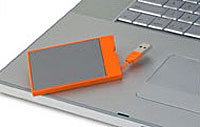 The shirt-pocket untroubling device can be used on both Macs (OS 9.x/10.x) and PCs (Windows 98SE through XP), with no additional software or drivers needed, although the credit-card sized storage device also ships with LaCie Silverlining and SilverKeeper drive management and backup utilities.
The shirt-pocket untroubling device can be used on both Macs (OS 9.x/10.x) and PCs (Windows 98SE through XP), with no additional software or drivers needed, although the credit-card sized storage device also ships with LaCie Silverlining and SilverKeeper drive management and backup utilities.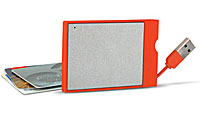 “Mobility, reliability, ease of use, capacity and price are the five main keys to consider when buying storage. We meet them all with the Carte Orange,” table-thumped Olivier Mirloup, LaCie Senior Product Manager.
“Mobility, reliability, ease of use, capacity and price are the five main keys to consider when buying storage. We meet them all with the Carte Orange,” table-thumped Olivier Mirloup, LaCie Senior Product Manager.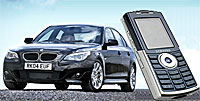 There’s been an orgy of synergistic back-scratching and brand backslapping going on in Samsung’s schmoozing department as the company announces an alliance with German luxury car brand, BMW.
There’s been an orgy of synergistic back-scratching and brand backslapping going on in Samsung’s schmoozing department as the company announces an alliance with German luxury car brand, BMW.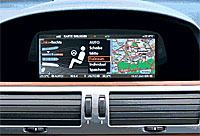 BMW drivers will be able to link the phone to the iDrive control interface, which features a control knob at the centre of the vehicle’s console, allowing access to various functions displayed on the in-dash monitor.
BMW drivers will be able to link the phone to the iDrive control interface, which features a control knob at the centre of the vehicle’s console, allowing access to various functions displayed on the in-dash monitor.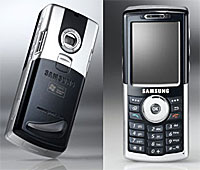 Samsung have already been poking their dipstick into the field of mobile-to-car technology, announcing a partnership with Audi back in July.
Samsung have already been poking their dipstick into the field of mobile-to-car technology, announcing a partnership with Audi back in July.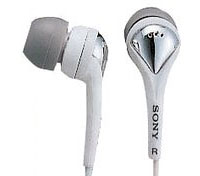 It’s almost always worthwhile upgrading the cheapskate headphones that invariably come bundled with MP3 players and phones – especially if you’re currently strutting around with a pair of
It’s almost always worthwhile upgrading the cheapskate headphones that invariably come bundled with MP3 players and phones – especially if you’re currently strutting around with a pair of 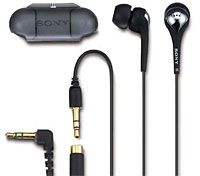 The closed-type Fontopia design is powered by super-small 9 mm drivers kitted out in Spinal Tap black with go-faster silver accents (they’re also available in Mac-like white, but that’s just asking for trouble).
The closed-type Fontopia design is powered by super-small 9 mm drivers kitted out in Spinal Tap black with go-faster silver accents (they’re also available in Mac-like white, but that’s just asking for trouble). After several years of battling with the clunky interface and weird quirks of our museum-ready OnDigital digital terrestrial television box, we decided it was time to replace it with something a little more contemporary.
After several years of battling with the clunky interface and weird quirks of our museum-ready OnDigital digital terrestrial television box, we decided it was time to replace it with something a little more contemporary.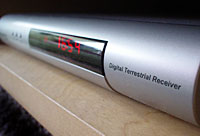 For the princely sum of just £35 (~$62, €52), the Wharfedale offers a digi box with a 7 day electronic programme guide (EPG), digital text, digital interactive services, DVB subtitles, auto scan and setup and 2 SCART sockets.
For the princely sum of just £35 (~$62, €52), the Wharfedale offers a digi box with a 7 day electronic programme guide (EPG), digital text, digital interactive services, DVB subtitles, auto scan and setup and 2 SCART sockets. Onscreen menus
Onscreen menus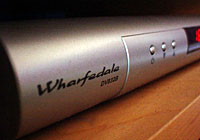 Picture quality
Picture quality Fujitsu Siemens have launched the “first handhelds with fully integrated GPS functionality”, the Pocket LOOX N500 and Pocket LOOX N520 PDAs.
Fujitsu Siemens have launched the “first handhelds with fully integrated GPS functionality”, the Pocket LOOX N500 and Pocket LOOX N520 PDAs.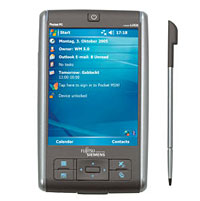 Powered by an Intel XScale PXA270 312 MHz CPU, the devices come with a SD/MMC slot (with support for SDIO), USB 1.1, IrDA and Bluetooth, with the Pocket LOOX N520 offering integrated wireless LAN 802.11g Wi-Fi.
Powered by an Intel XScale PXA270 312 MHz CPU, the devices come with a SD/MMC slot (with support for SDIO), USB 1.1, IrDA and Bluetooth, with the Pocket LOOX N520 offering integrated wireless LAN 802.11g Wi-Fi.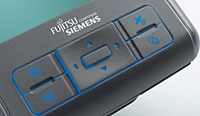 There’s also a ton of Fujitsu Siemens-branded applications bundled in the package, including Voice recorder, AudioPath and Key Look, along with a Microsoft Mobile suite including Excel, Power Point, Outlook and Internet Explorer.
There’s also a ton of Fujitsu Siemens-branded applications bundled in the package, including Voice recorder, AudioPath and Key Look, along with a Microsoft Mobile suite including Excel, Power Point, Outlook and Internet Explorer.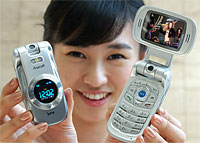 Released today in Korea, the land where they get all the cool gadgets first, Samsung’s new SCH V700 handset has the honour of being the first PMP (Portable Media Player) phone in the world.
Released today in Korea, the land where they get all the cool gadgets first, Samsung’s new SCH V700 handset has the honour of being the first PMP (Portable Media Player) phone in the world. The V700 comes in Samsung’s favoured clamshell design with the added twist of a tilting display which lets users rotate the screen 90 degrees to take advantage of a wider display (it looks a bit like ET to us in this position, but maybe we’ve been overdoing it a bit recently.)
The V700 comes in Samsung’s favoured clamshell design with the added twist of a tilting display which lets users rotate the screen 90 degrees to take advantage of a wider display (it looks a bit like ET to us in this position, but maybe we’ve been overdoing it a bit recently.)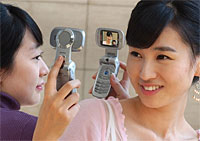 We’re impressed with the onboard TV out port which could prive a great way of sharing your photos with chums.
We’re impressed with the onboard TV out port which could prive a great way of sharing your photos with chums.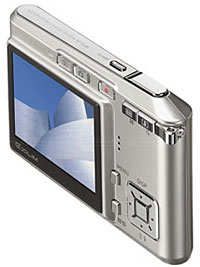 CASIO have announced their new, wafer-thin EXILIM CARD EX-S600 digital camera.
CASIO have announced their new, wafer-thin EXILIM CARD EX-S600 digital camera.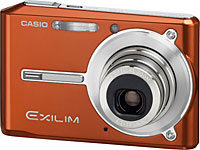 According to Casio’s announcement, Revive Shot mode “adjusts for obliquity as well as brightly refreshes faded colours.”
According to Casio’s announcement, Revive Shot mode “adjusts for obliquity as well as brightly refreshes faded colours.”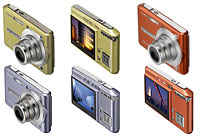 As is de rigeur on consumer compacts, there’s a built in movie mode with the Casio capturing MPEG-4, VGA (640×480 pixels) at 30 frames/second.
As is de rigeur on consumer compacts, there’s a built in movie mode with the Casio capturing MPEG-4, VGA (640×480 pixels) at 30 frames/second.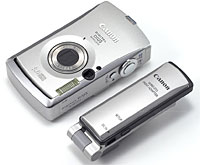 Canon are trumpeting that they are “bringing IXUS style and performance to the wireless age” with the release of their PowerShot camera.
Canon are trumpeting that they are “bringing IXUS style and performance to the wireless age” with the release of their PowerShot camera.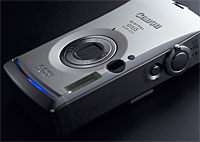 The camera can be registered with up to 8 target devices including wireless access points via a secure communication system to prevent eavesdropping or interception of your photographic masterpieces.
The camera can be registered with up to 8 target devices including wireless access points via a secure communication system to prevent eavesdropping or interception of your photographic masterpieces. Although we naturally warm to the convenience and sheer ‘techiness’ of Wi-Fi enabled digital cameras, we remain to be convinced that the technology has reached maturity yet.
Although we naturally warm to the convenience and sheer ‘techiness’ of Wi-Fi enabled digital cameras, we remain to be convinced that the technology has reached maturity yet. We speak from some experience here too, after foolishly being seduced by Sony’s innovative – but frankly pointless – Bluetooth feature on its 20002 DSC FX77 camera.
We speak from some experience here too, after foolishly being seduced by Sony’s innovative – but frankly pointless – Bluetooth feature on its 20002 DSC FX77 camera.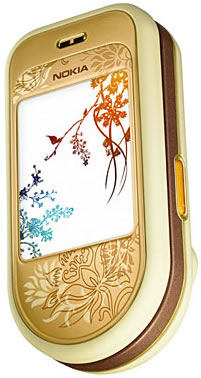 Mobile phone giants Nokia have announced three new phone models aimed at the “style-conscious” market.
Mobile phone giants Nokia have announced three new phone models aimed at the “style-conscious” market.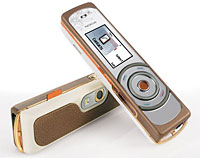 Desperately described as a phone for “trend-setting men and women who enjoy being the centre of attention,” the highly distinctive 7380 looks like it’s come from the same bonkers design studio as the
Desperately described as a phone for “trend-setting men and women who enjoy being the centre of attention,” the highly distinctive 7380 looks like it’s come from the same bonkers design studio as the 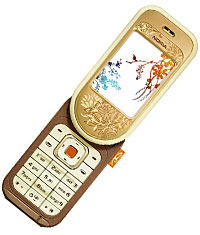 Employing a sliding keypad, the Nokia 7370 comes with a 2-inch QVGA colour screen (320 x 240 pixels), stereo speakers with 3D sound effects and a 1.3 megapixel camera (8x zoom) onboard.
Employing a sliding keypad, the Nokia 7370 comes with a 2-inch QVGA colour screen (320 x 240 pixels), stereo speakers with 3D sound effects and a 1.3 megapixel camera (8x zoom) onboard.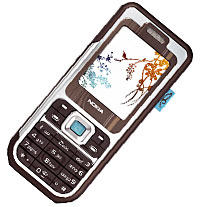 Nokia 7360
Nokia 7360